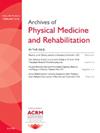NIDILRR ARRT: Translating Research to Clinical Practice: Implementing Surface Electromyography for Swallowing Management in a Rehabilitation Hospital
IF 3.6
2区 医学
Q1 REHABILITATION
Archives of physical medicine and rehabilitation
Pub Date : 2025-04-01
DOI:10.1016/j.apmr.2025.01.008
引用次数: 0
Abstract
Objectives
To examine the perspectives of speech-language pathologists (SLPs) about the implementation of a surface electromyography (sEMG) device in swallowing therapy.
Design
Descriptive survey and qualitative study.
Setting
Rehabilitation hospital.
Participants
Forty-four SLPs (mean age, 32.9y, SD, 7.1y) answered a preimplementation survey about biofeedback use in swallowing management and barriers to sEMG use in clinical practice. Six clinicians (mean age, 35.2y, SD, 4.8y) participated in the sEMG implementation process for 5 months.
Interventions
sEMG.
Main Outcome Measures
Preimplementation survey addressed (i) biofeedback use in swallowing management, (ii) sEMG knowledge, and (iii) barriers to sEMG use in clinical practice. Implementation process included (i) number of patients and sessions using sEMG and (ii) SLPs perceptions of sEMG implementation.
Results
Preimplementation survey indicated that the most used biofeedback modalities in swallowing management were an oral manometry device (97.7%), sEMG (11.4%), and fiberoptic endoscopic examination of swallowing (11.4%). All clinicians reported that sEMG improves visualization of muscle activity to train swallowing exercises, improves patient outcomes (77.3%), and motivates patients during therapy (45.5%). Main barriers to sEMG use included reduced knowledge (86.4%), lack of training (86.4%), and equipment access (68.2%). The 6 SLPs attended 4 educational/training meetings prior to implementation. They used sEMG with 30 patients (ages, 35-93y) for a total of 105 sessions. Clinicians reported being satisfied using sEMG (median, 8; interquartile range, 2.25; on a scale from 0 to 10), and their confidence level in using it during swallowing therapy was high (median, 8; interquartile range, 2.25). Although the SLPs recommended the implementation of sEMG throughout the hospital, they suggested that implementation should include onsite mentoring and supervised sessions when clinicians initially use sEMG with patients.
Conclusions
The education and training meetings improved clinicians’ knowledge, skill acquisition, and competency, facilitating sEMG use in swallowing therapy. The acceptability and adoption of sEMG was enhanced by researchers working in partnership with clinicians to identify strategies to address implementation barriers.
Disclosures
none.
NIDILRR ARRT:将研究转化为临床实践:在康复医院实施表面肌电图吞咽管理
目标研究言语病理学家(SLPs)对在吞咽治疗中实施表面肌电图(sEMG)设备的看法。设计描述性调查和定性研究。参与者44名SLPs(平均年龄32.9岁,SD为7.1岁)回答了一项实施前调查,内容涉及在吞咽管理中使用生物反馈以及在临床实践中使用sEMG的障碍。六名临床医生(平均年龄 35.2 岁,标准差 4.8 岁)参与了为期 5 个月的 sEMG 实施过程。干预措施sEMG.主要结果测量实施前调查涉及(i)吞咽管理中生物反馈的使用情况,(ii)sEMG 知识,以及(iii)临床实践中使用 sEMG 的障碍。实施过程包括:(i) 使用 sEMG 的患者和疗程的数量;(ii) SLPs 对实施 sEMG 的看法。结果实施前调查显示,在吞咽管理中使用最多的生物反馈模式是口腔测压仪(97.7%)、sEMG(11.4%)和纤维内窥镜吞咽检查(11.4%)。所有临床医生都表示,sEMG 可提高肌肉活动的可视化程度以训练吞咽运动,改善患者的治疗效果(77.3%),并在治疗过程中激励患者(45.5%)。使用 sEMG 的主要障碍包括知识不足(86.4%)、缺乏培训(86.4%)和设备使用(68.2%)。在实施前,6 名辅助语言治疗师参加了 4 次教育/培训会议。他们对 30 名患者(年龄在 35-93 岁之间)使用了 sEMG,共进行了 105 次治疗。临床医生对使用 sEMG 表示满意(中位数,8;四分位数间距,2.25;从 0 到 10),他们在吞咽治疗中使用 sEMG 的信心水平也很高(中位数,8;四分位数间距,2.25)。尽管语言康复师建议在全院范围内使用 sEMG,但他们建议,在临床医生最初对患者使用 sEMG 时,应包括现场指导和监督课程。通过研究人员与临床医生合作,确定解决实施障碍的策略,提高了 sEMG 的可接受性和采用率。
本文章由计算机程序翻译,如有差异,请以英文原文为准。
求助全文
约1分钟内获得全文
求助全文
来源期刊
CiteScore
6.20
自引率
4.70%
发文量
495
审稿时长
38 days
期刊介绍:
The Archives of Physical Medicine and Rehabilitation publishes original, peer-reviewed research and clinical reports on important trends and developments in physical medicine and rehabilitation and related fields. This international journal brings researchers and clinicians authoritative information on the therapeutic utilization of physical, behavioral and pharmaceutical agents in providing comprehensive care for individuals with chronic illness and disabilities.
Archives began publication in 1920, publishes monthly, and is the official journal of the American Congress of Rehabilitation Medicine. Its papers are cited more often than any other rehabilitation journal.

 求助内容:
求助内容: 应助结果提醒方式:
应助结果提醒方式:


